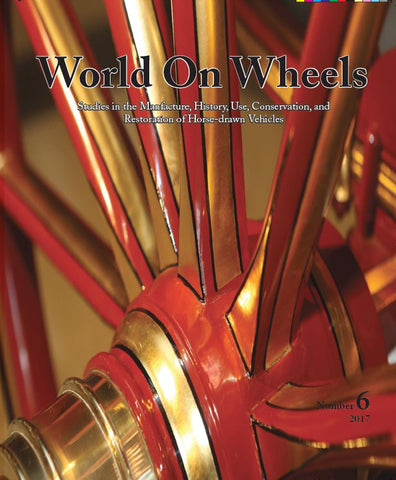
Conservation and Restoration of Horse Drawn Vehicles by Susan Green
$ 35.00
Now back in print, this book published by the Carriage Museum of America, is a must have resource. The purpose of this book is to help the owner of a horse drawn vehicle conserve and/or restore his vehicle in order to enhance its value or conserve an irreplaceable historical artifact. Conserving and restoring a horse drawn vehicle is a complex undertaking that requires the skills of a wide variety of artisans and craftsman knowledgeable in crafts that are no longer widely practiced or well understood. Any deviation from the materials or structures used in the original design drastically reduce the monetary and historical value of the vehicle.
This book, therefore, sets out to define the levels of conservation and restoration, the specific steps involved in restoration, the sources for materials and special tools necessary for the work, and most important, names of some of the craftsmen and artisans skilled in the special talents required to produce excellent results. In addition to the steps involved in conservation and restoration, the book provides some historical background on the design, engineering and manufacture of horse drawn vehicles to help the present owner understand the value of proper conservation or restoration, and gain an appreciation for the ingenuity and brilliant skills the original builders exercised in producing his vehicle.
Topics include: Research and Recording; Guidelines for Selecting a Conservator; Conservation Treatment of Horse Drawn Vehicles; Pitfalls of Restoration; Conservation Ethics; Stable and Reversible Materials; Documentation; Carriage Technology; Causes/Prevention of Deterioration; Paint Stabilization; Varnish Cleaning; Varnish Removal; Overpainting; Metal Components; Upholstery; Routine Maintenance; Dusting; Dust Covers; Varnish/Paint Maintenance; Supply Resource List; Technical Examination and Microscopic Analysis of Painted Horse Drawn Vehicles; Recipes for Varnishes; Axles; Wooden Axles; Inspecting the Axles Before Buying and Restoration; Wheels; Patent Wheels; Dish in Wheels; Hubs; Spokes; Rims; Fellowes; Color of Rubber Tires; Springs; Having New Springs Made; Faults in Spring Fixing; Spring Manufacturing; Panels; Natural Wood panels; Brass Bead Molding; Laminating Thin Layers; Painting; Preparing for Painting; Tip for Removing Rusty Screws; Gluing; Sanding; Brush Painting; Striping; Spray Painting; Colors; Scrolling; Ornamenting; Trimming and Stuffing; Floor Coverings; Upholstery; Lamps; Wicker and Cane Work; Imitation Cane Work; Sham-Caning; Drafting; Museums; etc.
This book, therefore, sets out to define the levels of conservation and restoration, the specific steps involved in restoration, the sources for materials and special tools necessary for the work, and most important, names of some of the craftsmen and artisans skilled in the special talents required to produce excellent results. In addition to the steps involved in conservation and restoration, the book provides some historical background on the design, engineering and manufacture of horse drawn vehicles to help the present owner understand the value of proper conservation or restoration, and gain an appreciation for the ingenuity and brilliant skills the original builders exercised in producing his vehicle.
Topics include: Research and Recording; Guidelines for Selecting a Conservator; Conservation Treatment of Horse Drawn Vehicles; Pitfalls of Restoration; Conservation Ethics; Stable and Reversible Materials; Documentation; Carriage Technology; Causes/Prevention of Deterioration; Paint Stabilization; Varnish Cleaning; Varnish Removal; Overpainting; Metal Components; Upholstery; Routine Maintenance; Dusting; Dust Covers; Varnish/Paint Maintenance; Supply Resource List; Technical Examination and Microscopic Analysis of Painted Horse Drawn Vehicles; Recipes for Varnishes; Axles; Wooden Axles; Inspecting the Axles Before Buying and Restoration; Wheels; Patent Wheels; Dish in Wheels; Hubs; Spokes; Rims; Fellowes; Color of Rubber Tires; Springs; Having New Springs Made; Faults in Spring Fixing; Spring Manufacturing; Panels; Natural Wood panels; Brass Bead Molding; Laminating Thin Layers; Painting; Preparing for Painting; Tip for Removing Rusty Screws; Gluing; Sanding; Brush Painting; Striping; Spray Painting; Colors; Scrolling; Ornamenting; Trimming and Stuffing; Floor Coverings; Upholstery; Lamps; Wicker and Cane Work; Imitation Cane Work; Sham-Caning; Drafting; Museums; etc.




